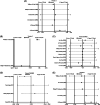Serum vitamins and homocysteine levels in autoimmune liver disease: A systematic review and meta-analysis
- PMID: 38652023
- PMCID: PMC11037259
- DOI: 10.1002/iid3.1258
Serum vitamins and homocysteine levels in autoimmune liver disease: A systematic review and meta-analysis
Abstract
Objective: Vitamins and homocysteine (Hcy) are involved in liver metabolism and related to the pathogenesis of autoimmune liver disease (AILD), but consensus is lacking. This study aims to systematically summarize relevant evidence to clarify the association of serum vitamins and Hcy levels with AILD.
Methods: The English and Chinese literature was searched until August 29, 2023. Studies were included if they were observational studies of investigating serum vitamins and Hcy levels in patients with AILD and their healthy comparisons. Quality assessment was performed by using the Newcastle-Ottawa Scale, and a meta-analysis was conducted using ReviewManager 5.3. The protocol was registered in the international prospective register of systematic reviews (PROSPERO), with registration number CRD42023455367.
Results: A total of 25 case-control studies comprising 3487 patients (1673 patients and 1814 healthy controls) were included for analysis. There were 548 autoimmune hepatitis (AIH) cases, 1106 primary biliary cholangitis (PBC) cases, and 19 primary sclerosing cholangitis (PSC) cases. We found that serum A and E were decreased in both AIH and PBC/PSC; but vitamin C was reduced only in patients with PBC, not AIH. In addition, decreased content of 25(OH)D3 was found in both AIH and PBC. However, levels of 25(OH)D did not differ between the patients and controls, and were independent of disease types and the country. Only one study that met the inclusion criteria reported vitamin B6, B9, B12, and Hcy changes, and found that vitamin B6 and B9 were significantly decreased in patients with PBC, while serum vitamin B12 and Hcy levels were significantly elevated in them. One eligible study each confirmed a reduction in plasma vitamin K1 and 1,25(OH)2D3 in patients with PBC.
Conclusion: Most vitamins are deficient in AILD, so appropriate vitamin supplementation should be necessary. Further studies with larger sample sizes are needed to validate these findings.
Keywords: autoimmune hepatitis; autoimmune liver disease; meta‐analysis; primary biliary cholangitis; vitamins.
© 2024 The Authors. Immunity, Inflammation and Disease published by John Wiley & Sons Ltd.
Conflict of interest statement
None declared.
Figures








Similar articles
-
Effectiveness and safety of vitamin D in relation to bone health.Evid Rep Technol Assess (Full Rep). 2007 Aug;(158):1-235. Evid Rep Technol Assess (Full Rep). 2007. PMID: 18088161 Free PMC article.
-
Home treatment for mental health problems: a systematic review.Health Technol Assess. 2001;5(15):1-139. doi: 10.3310/hta5150. Health Technol Assess. 2001. PMID: 11532236
-
Systemic pharmacological treatments for chronic plaque psoriasis: a network meta-analysis.Cochrane Database Syst Rev. 2021 Apr 19;4(4):CD011535. doi: 10.1002/14651858.CD011535.pub4. Cochrane Database Syst Rev. 2021. Update in: Cochrane Database Syst Rev. 2022 May 23;5:CD011535. doi: 10.1002/14651858.CD011535.pub5. PMID: 33871055 Free PMC article. Updated.
-
Nutritional interventions for survivors of childhood cancer.Cochrane Database Syst Rev. 2016 Aug 22;2016(8):CD009678. doi: 10.1002/14651858.CD009678.pub2. Cochrane Database Syst Rev. 2016. PMID: 27545902 Free PMC article.
-
The effect of vitamin B6 on cognition.Cochrane Database Syst Rev. 2003;(4):CD004393. doi: 10.1002/14651858.CD004393. Cochrane Database Syst Rev. 2003. PMID: 14584010
Cited by
-
Role and Relationship Between Homocysteine and H2S in Ischemic Stroke.Mol Neurobiol. 2025 May 6. doi: 10.1007/s12035-025-04968-5. Online ahead of print. Mol Neurobiol. 2025. PMID: 40327309 Review.
-
The Impact of the Mediterranean Diet on Telomere Biology: Implications for Disease Management-A Narrative Review.Nutrients. 2024 Aug 2;16(15):2525. doi: 10.3390/nu16152525. Nutrients. 2024. PMID: 39125404 Free PMC article. Review.
References
-
- Carbone M, Neuberger JM. Autoimmune liver disease, autoimmunity and liver transplantation. J Hepatol. 2014;60:210‐223. - PubMed
-
- Czaja AJ. Hepatocellular carcinoma and other malignancies in autoimmune hepatitis. Dig Dis Sci. 2013;58:1459‐1476. - PubMed
-
- Adam R, Karam V, Delvart V, et al. Evolution of indications and results of liver transplantation in Europe. A report from the European Liver Transplant Registry (ELTR). J Hepatol. 2012;57:675‐688. - PubMed
-
- Duclos‐Vallee JC, Sebagh M. Recurrence of autoimmune disease, primary sclerosing cholangitis, primary biliary cirrhosis, and autoimmune hepatitis after liver transplantation. Liver Transpl. 2009;15(suppl 2):S25‐S34. - PubMed
-
- Carbone M, Mells GF, Alexander GJ, et al. Calcineurin inhibitors and the IL12A locus influence risk of recurrent primary biliary cirrhosis after liver transplantation. Am J Transplant (AJT). 2013;13:1110‐1111. - PubMed
Publication types
MeSH terms
Substances
Grants and funding
LinkOut - more resources
Full Text Sources
Miscellaneous

